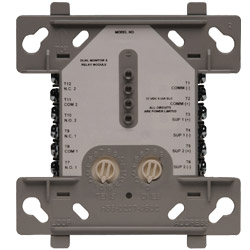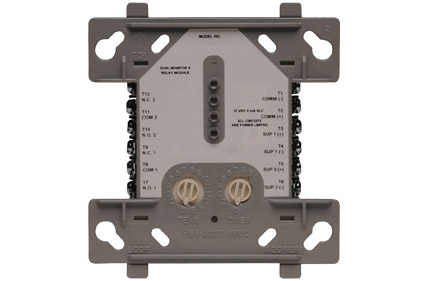 Combining two relay outputs and two monitor inputs into one device is the Two In/Two Out multifunction module. The module is capable of Class B supervised wiring to the monitored devices. It also contains Form C relay contacts, allowing the panel to switch the contacts on command. There is a dedicated LED on the module for each input and output. The control panel can use these bicolor LEDs to indicate normal, alarm, and trouble conditions. The module is ideal for areas where inputs and outputs are needed in the same location, such as smoke/fire dampers, HVAC fan, nondedicated smoke fan, dedicated smoke control, or security doors. According to the manufacturer, the savings of using one device compared to four can be beneficial in any type of building, but adds up quickly in high-rise buildings or large shopping complexes, according to the company. The two input/two output module is the same size as standard single modules. It can mount directly to a 4-inch square electrical box, the surface-mounted SMB500, or into a DNR(W) duct housing. The base address is selected via rotary switch and assigned to relay output #1 from 00 to 156. The module will automatically assign the next three addresses as appropriate to monitored input #1, relay output #2, and monitored input #2. If relay output #2 or monitored input #2 are not used, it is possible to disable those addresses via DIP switch. Those two addresses will then be free to be used for other devices on the loop.
Combining two relay outputs and two monitor inputs into one device is the Two In/Two Out multifunction module. The module is capable of Class B supervised wiring to the monitored devices. It also contains Form C relay contacts, allowing the panel to switch the contacts on command. There is a dedicated LED on the module for each input and output. The control panel can use these bicolor LEDs to indicate normal, alarm, and trouble conditions. The module is ideal for areas where inputs and outputs are needed in the same location, such as smoke/fire dampers, HVAC fan, nondedicated smoke fan, dedicated smoke control, or security doors. According to the manufacturer, the savings of using one device compared to four can be beneficial in any type of building, but adds up quickly in high-rise buildings or large shopping complexes, according to the company. The two input/two output module is the same size as standard single modules. It can mount directly to a 4-inch square electrical box, the surface-mounted SMB500, or into a DNR(W) duct housing. The base address is selected via rotary switch and assigned to relay output #1 from 00 to 156. The module will automatically assign the next three addresses as appropriate to monitored input #1, relay output #2, and monitored input #2. If relay output #2 or monitored input #2 are not used, it is possible to disable those addresses via DIP switch. Those two addresses will then be free to be used for other devices on the loop.
System Sensor
800-736-7672
www.systemsensor.com
eProduct 190


Report Abusive Comment